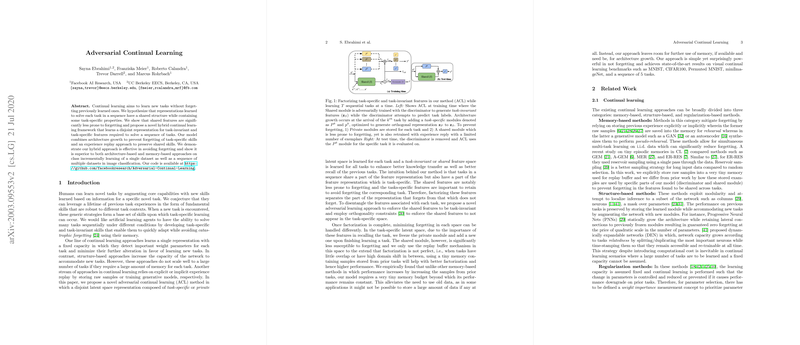Insightful Overview of "Adversarial Continual Learning"
The academic paper titled "Adversarial Continual Learning" by Ebrahimi et al. proposes a hybrid framework aimed at addressing the well-recognized challenge of catastrophic forgetting in continual learning scenarios. Continual learning models typically struggle to retain previously acquired knowledge while learning new tasks, a hurdle that this paper attempts to mitigate through a novel adversarial approach.
The authors start by building upon the premise that task-specific properties and shared representations can coexist in neural networks trained on sequential tasks. They introduce a framework that separates representations into task-specific and task-invariant components. This separation is achieved through a blend of adversarial training, architectural strategies, and memory techniques, forming a robust solution for tackling catastrophic forgetting.
Core Methodology
The approach, termed Adversarial Continual Learning (ACL), leverages adversarial learning—a technique commonly associated with generative adversarial networks (GANs)—to deduce task-invariant representations (shared features) while isolating task-specific ones. The architecture combines:
- Shared Module: Task-invariant features are learned and protected from modification by an adversarial setup where a discriminator attempts to predict the task from the shared representation. Meanwhile, the shared module is trained to fool this discriminator, ensuring task-invariance.
- Private Modules: To handle task-specific information, separate modules are added for each new task, housing task-specific features which are inherently more susceptible to forgetting.
- Orthogonality Constraints: These are enforced to ensure distinct separation between shared and private feature spaces, using orthogonality techniques to maintain spaces' independence.
- Memory Utilization: A minimal replay buffer is employed to assist in maintaining the integrity of shared features, particularly when tasks have little overlap or domain shifts.
Empirical Analysis
The experimental evaluation across various standard continual learning datasets, including the commonly used 5-Split MNIST, Permuted MNIST, and CIFAR100, demonstrates that ACL consistently achieves higher accuracy and lower forgetting scores compared to a host of state-of-the-art methods. Particularly notable is its robustness to incremental task addition; ACL maintains performance using minimal memory, indicative of its efficient knowledge retention capabilities.
For example, on the 20-Split miniImageNet, ACL achieves an impressive accuracy of 62.07%, making use of architecture growth and a tiny replay buffer storing merely one sample per class. This is in stark contrast to other methods which rely heavily on extensive memory usage and are often burdened by substantial forgetting. Such results underscore ACL’s competency in simultaneously juggling task-specific learning and shared representation retention.
Implications and Future Directions
The ACL methodology presents compelling implications for the development of learning systems capable of long-term knowledge retention and adaptation. Its adversarial architecture that effectively separates task-specific and task-invariant features can potentially inspire a new class of continual learning models better equipped for real-world applications where the task spectrum is vast and unstructured.
Future improvements could involve exploring deeper and more complex architectures to further extend ACL’s applicability. Integration with more advanced experience replay mechanisms, or combining with other scalable learning frameworks, could enhance its performance, particularly in settings with tight computational or memory constraints. Additionally, extending the method to handle more diverse input modalities could further establish its versatility across different verticals of artificial intelligence.
Ultimately, the paper endorses a unified and adversarial approach as a promising pathway towards sustainable continual learning, providing a solid foundation upon which future inquiries can build.
